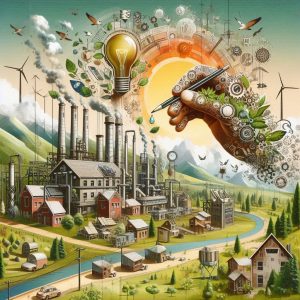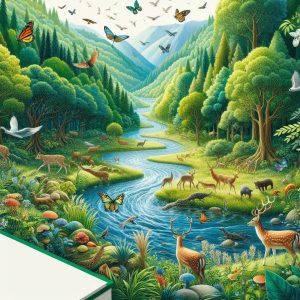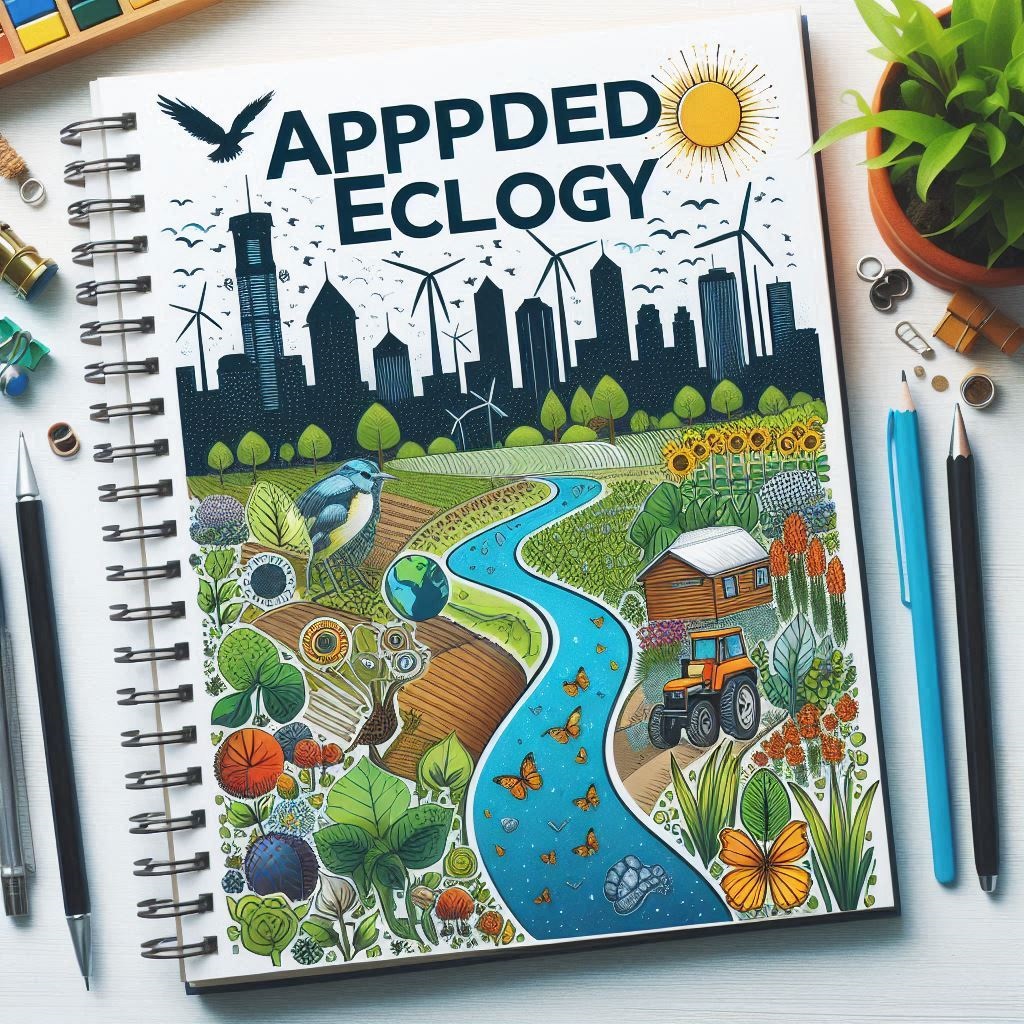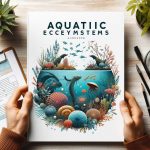Applied Ecology: Bridging Theory and Practice
Applied ecology is a branch of ecology focused on solving real-world environmental problems through the application of ecological principles. Unlike theoretical ecology, which emphasizes understanding natural processes and systems, applied ecology aims to address practical issues related to ecosystem management, conservation, and sustainability. This article explores the core aspects of applied ecology, including its principles, methodologies, applications, and case studies. It highlights the importance of integrating ecological research with practical solutions to foster a sustainable relationship between humans and the environment.
Principles of Applied Ecology
Applied ecology is grounded in several core principles that guide its approach to solving environmental challenges. These principles include:
1. Ecosystem Approach
An ecosystem approach involves studying and managing ecological systems as a whole rather than focusing on individual species or components. This holistic perspective recognizes the complex interactions between organisms and their environments. For example, managing a wetland ecosystem requires understanding not only the aquatic plants and animals but also the interactions with surrounding terrestrial habitats and human activities. For further reading on the ecosystem approach, visit CBD Ecosystem Approach.
2. Sustainable Management
Sustainable management aims to balance ecological, social, and economic factors to ensure that natural resources are used in a way that meets current needs without compromising the ability of future generations to meet their own needs. This principle is crucial in areas such as forestry, fisheries, and agriculture, where overexploitation and environmental degradation can lead to long-term negative consequences. Learn more about sustainable management practices at UN Sustainable Development Goals.
3. Adaptive Management
Adaptive management is an iterative process that involves continuously monitoring and adjusting management strategies based on new information and changing conditions. This approach allows for flexibility and responsiveness in dealing with uncertainties and dynamic environmental systems. For instance, wildlife management strategies might be adjusted based on population trends and habitat changes. For more insights into adaptive management, visit U.S. Fish & Wildlife Adaptive Management.
Methodologies in Applied Ecology
Applied ecology employs a variety of methodologies to address environmental issues effectively. These methodologies include:
1. Field Surveys and Monitoring
Field surveys involve the systematic collection of data from natural environments to assess ecological conditions, species distributions, and habitat characteristics. Monitoring programs track changes over time, providing critical information for evaluating the effectiveness of management strategies and identifying emerging issues. Examples include bird censuses, vegetation surveys, and water quality monitoring. For detailed guidelines on field surveys, visit EPA Monitoring Programs.
2. Remote Sensing and GIS
Remote sensing involves using satellite or aerial imagery to collect data on large-scale environmental patterns and changes. Geographic Information Systems (GIS) are used to analyze and visualize spatial data, aiding in the assessment of land use, habitat fragmentation, and environmental impacts. These tools are essential for managing landscapes and planning conservation strategies. For more on remote sensing and GIS, visit NASA Landsat Missions.
3. Modeling and Simulation
Modeling and simulation involve creating mathematical or computational models to predict ecological outcomes and assess the potential impacts of different management scenarios. These models can simulate population dynamics, habitat changes, and the effects of climate change. They are valuable tools for decision-making and scenario analysis. For information on ecological modeling, visit Ecology and Society on Modeling.
4. Experimental Studies
Experimental studies involve manipulating variables in controlled conditions to understand ecological processes and test hypotheses. These studies can be conducted in laboratory settings, field experiments, or through controlled environmental simulations. Experimental research helps identify causal relationships and evaluate the effectiveness of management interventions. For more on experimental ecology, check Frontiers in Ecology and Evolution.
Applications of Applied Ecology
Applied ecology addresses a wide range of environmental issues through practical applications. Some key areas include:
1. Conservation Biology
Conservation biology focuses on preserving biodiversity and protecting endangered species. Applied ecology plays a critical role in developing and implementing conservation strategies, such as habitat restoration, species reintroduction, and the establishment of protected areas. By using ecological principles, conservation biologists can address threats to biodiversity and work towards sustainable solutions. For more on conservation biology, visit CBD Conservation.
Key Concepts in Conservation Biology
1. Biodiversity and Its Importance
Biodiversity refers to the variety of life on Earth, including genetic diversity, species diversity, and ecosystem diversity. It is crucial for ecosystem resilience, human well-being, and the provision of ecosystem services. Conservation biology emphasizes the importance of preserving this diversity to maintain ecological balance and prevent the collapse of ecosystems. For a comprehensive overview of biodiversity, visit Convention on Biological Diversity.
2. Threats to Biodiversity
The major threats to biodiversity include habitat destruction, climate change, pollution, overexploitation, and invasive species. These factors contribute to the decline of species and ecosystems and disrupt ecological processes. Understanding these threats is essential for developing effective conservation strategies. For detailed information on these threats, visit IUCN on Biodiversity Threats.
3. Conservation Strategies
Conservation biology employs various strategies to protect and restore biodiversity. These include:
- Species Protection: Efforts to protect endangered species through legal measures, habitat management, and captive breeding.
- Habitat Conservation: Initiatives to preserve and restore critical habitats to support diverse ecosystems.
- Protected Areas: Establishing national parks, wildlife reserves, and marine protected areas to safeguard natural environments.
- Invasive Species Management: Strategies to control or eradicate non-native species that threaten local biodiversity.
Applications of Conservation Biology
1. Species Recovery Programs
Species recovery programs aim to increase the populations of endangered species through various means such as habitat restoration, captive breeding, and reintroduction into the wild. Successful recovery programs include the U.S. Fish and Wildlife Service’s Recovery Programs and the Tiger Conservation Initiatives.
2. Ecosystem Restoration
Ecosystem restoration involves rehabilitating degraded ecosystems to restore their ecological functions and biodiversity. This can include reforestation, wetland restoration, and the removal of invasive species. Notable restoration projects include the Southern Appalachian Restoration and the Restoration Industry Association.
3. Conservation Policy and Advocacy
Conservation biology also involves influencing policy and advocating for laws that protect natural resources and biodiversity. This includes working with governments, NGOs, and the public to support environmental legislation and conservation initiatives. For examples of conservation advocacy, visit Earthjustice and Greenpeace USA.
Challenges and Future Directions
1. Climate Change
Climate change poses a significant threat to biodiversity by altering habitats, shifting species distributions, and affecting ecological processes. Conservation biology must address these challenges through adaptive management strategies and climate-resilient conservation practices. For insights into climate change impacts on biodiversity, visit Intergovernmental Panel on Climate Change (IPCC).
2. Human-Wildlife Conflicts
Human-wildlife conflicts arise when wildlife populations interact with human activities, leading to economic losses or threats to human safety. Conservation biology must develop solutions to mitigate these conflicts while ensuring the protection of both human interests and wildlife. Examples of conflict resolution include Wildlife Conservation Society’s Programs and The Wildlife Society.
3. Integration with Other Disciplines
Effective conservation requires collaboration across disciplines, including economics, sociology, and political science. Integrating these fields with conservation biology can enhance the development and implementation of conservation strategies. For interdisciplinary approaches in conservation, see Ecological Economics Journal and Conservation Biology Journal.
2. Environmental Restoration
Environmental restoration involves repairing and rehabilitating degraded ecosystems to restore their functionality and biodiversity. Applied ecology guides restoration efforts by providing insights into the ecological requirements of target species, the functioning of natural processes, and the design of effective restoration interventions. Successful restoration projects can improve ecosystem health and resilience. For detailed restoration practices, see Society for Ecological Restoration Standards.
3. Sustainable Agriculture
Sustainable agriculture aims to produce food in a way that is environmentally friendly, socially equitable, and economically viable. Applied ecology contributes to sustainable agriculture by promoting practices such as crop rotation, integrated pest management, and soil conservation. These practices help maintain soil health, reduce the use of harmful chemicals, and support ecosystem services. For more on sustainable agriculture, visit FAO Sustainable Agriculture.
4. Urban Ecology
Urban ecology explores the interactions between human populations and their urban environments. Applied ecology helps design and manage green spaces, enhance urban biodiversity, and mitigate the impacts of urbanization on natural systems. Urban ecology aims to create sustainable and resilient cities by integrating ecological principles into urban planning and development. For more on urban ecology, check Urban Ecology Institute.
5. Climate Change Mitigation
Climate Change Mitigation in Applied Ecology
Climate change mitigation involves strategies and actions aimed at reducing the intensity of climate change by decreasing greenhouse gas emissions and enhancing carbon sinks. In applied ecology, climate change mitigation integrates ecological principles with practical measures to address the impacts of climate change on ecosystems and biodiversity. This approach is essential for minimizing adverse effects and promoting resilience in natural and human systems.
Key Strategies in Climate Change Mitigation
1. Carbon Sequestration
Carbon sequestration refers to the process of capturing and storing atmospheric carbon dioxide (CO₂) to reduce greenhouse gas concentrations. Ecological methods for carbon sequestration include:
- Afforestation and Reforestation: Planting trees and restoring forests to absorb CO₂ from the atmosphere. For more information, visit UN on Afforestation and Reforestation.
- Wetland Restoration: Restoring wetlands to enhance their ability to sequester carbon and support biodiversity. Explore Wetlands International for details.
- Soil Carbon Sequestration: Enhancing soil management practices to increase soil carbon storage. Visit Soil Science Society of America for insights.
2. Sustainable Land Use and Agriculture
Sustainable land use and agricultural practices aim to minimize greenhouse gas emissions while promoting ecosystem health and productivity. Key approaches include:
- Climate-Smart Agriculture: Implementing practices that enhance productivity while reducing emissions. For more information, check out Climate-Smart Agriculture.
- Agroforestry: Integrating trees and shrubs into agricultural systems to improve biodiversity and sequester carbon. Learn more at Agroforestry Research Trust.
- Conservation Tillage: Reducing soil disturbance to enhance soil carbon storage. For details, visit NRCS Conservation Tillage.
3. Renewable Energy and Energy Efficiency
Transitioning to renewable energy sources and improving energy efficiency are critical for reducing greenhouse gas emissions. Key strategies include:
- Adoption of Renewable Energy: Utilizing wind, solar, hydro, and geothermal energy to replace fossil fuels. For more on renewable energy, visit International Energy Agency (IEA).
- Energy Efficiency Improvements: Enhancing energy use in buildings, transportation, and industry. Learn more at U.S. Department of Energy.
Role of Ecology in Climate Change Mitigation
1. Ecosystem Management
Effective ecosystem management supports climate change mitigation by maintaining and restoring natural processes that sequester carbon and regulate climate. This includes protecting forests, wetlands, and grasslands that play significant roles in carbon storage and climate regulation. Explore Forest Trends for insights on ecosystem management practices.
2. Research and Monitoring
Ecological research and monitoring provide critical data on climate change impacts and the effectiveness of mitigation strategies. This includes studying changes in species distributions, ecosystem functions, and carbon fluxes. For cutting-edge research, visit Nature Climate Change.
3. Policy and Advocacy
Ecologists play a key role in shaping climate policies and advocating for effective mitigation measures. Their expertise informs policy decisions and helps integrate ecological considerations into climate action plans. For examples of policy advocacy, visit Convention on Biological Diversity and CBC News on Environmental Policy.

Challenges and Future Directions
1. Integrating Mitigation with Adaptation
Balancing mitigation efforts with adaptation strategies is crucial for addressing both the causes and effects of climate change. This requires a coordinated approach that considers ecological and socio-economic factors. For insights into integrating mitigation and adaptation, visit IPCC Special Report on Global Warming.
2. Scaling Up Efforts
Scaling up climate change mitigation efforts to a global level is essential for achieving meaningful impact. This includes expanding successful local and regional initiatives to broader contexts. Explore Global Carbon Project for examples of large-scale mitigation initiatives.
3. Engaging Communities and Stakeholders
Engaging local communities and stakeholders in climate change mitigation is vital for ensuring the effectiveness and sustainability of efforts. Community-based approaches and participatory planning can enhance the adoption of mitigation strategies. For community engagement strategies, visit United Nations Sustainable Development Goals.
Conclusion
Applied ecology bridges the gap between theoretical ecological research and practical environmental management, offering solutions to real-world problems through the application of ecological principles. By integrating aspects such as conservation biology, climate change mitigation, land management, and restoration ecology, applied ecology provides crucial insights and strategies for preserving biodiversity, managing ecosystems, and addressing environmental challenges.
As we face escalating environmental pressures from climate change, habitat loss, and pollution, the role of applied ecology becomes increasingly vital. Through innovative research, collaborative efforts, and adaptive management practices, applied ecology aims to enhance ecosystem resilience, promote sustainable use of natural resources, and support global conservation goals. For those engaged in environmental science and management, embracing the principles and methodologies of applied ecology is essential for crafting effective and sustainable solutions to the pressing ecological issues of our time.
Looking forward, the continued advancement of applied ecology will be crucial in navigating the complexities of environmental management and sustainability. Ongoing research, technological advancements, and policy initiatives will shape the future of this field, driving progress towards a more balanced and resilient relationship between humans and the natural world. For further exploration of applied ecology, visit resources such as Applied Ecology Journal and Nature Applied Ecology.
FAQs

What is applied ecology?
Applied ecology is a branch of ecology that focuses on using ecological knowledge and principles to address real-world environmental issues. It involves applying scientific research to practical problems in areas such as conservation, land management, and environmental policy.
Why is applied ecology important?
Applied ecology is crucial for solving practical environmental challenges. It helps in the development of strategies for conservation, restoration, and sustainable management of natural resources, aiming to balance ecological health with human needs.
What are some common methods used in applied ecology?
Common methods in applied ecology include field surveys, ecological modeling, remote sensing, and statistical analysis. These techniques are used to collect data, monitor ecosystems, and assess the impacts of various environmental interventions.
How can applied ecology contribute to climate change mitigation?
Applied ecology contributes to climate change mitigation through strategies such as carbon sequestration, sustainable land management, and ecosystem restoration. By implementing ecological practices that reduce greenhouse gas emissions and enhance carbon storage, applied ecology supports efforts to combat climate change.
Where can I find more information on applied ecology?
For further information on applied ecology, you can refer to reputable sources such as Applied Ecology Journal and Nature Applied Ecology.
Disclaimers
The information provided in this article is intended for general informational purposes only and should not be considered as professional or expert advice. While efforts have been made to ensure the accuracy and reliability of the information, the field of applied ecology is continually evolving. For specific advice or detailed information, consult with a professional ecologist or environmental scientist.
This article may contain links to external websites. These links are provided for convenience and informational purposes only. The inclusion of a link does not imply endorsement or responsibility for the content or opinions expressed on those external sites.
Cautions
When applying ecological principles to real-world problems, it is important to consider the complexity and variability of ecosystems. Interventions based on ecological research may have unintended consequences, and outcomes can vary depending on specific contexts and conditions.
Be aware of potential conflicts between ecological goals and human interests. Effective applied ecology requires balancing ecological health with social, economic, and cultural factors. Engaging stakeholders and considering diverse perspectives can help mitigate conflicts and enhance the effectiveness of ecological interventions.
- Always stay updated with the latest research and guidelines in the field of applied ecology. As scientific knowledge advances, new methods and strategies may emerge, requiring adjustments to existing practices.



